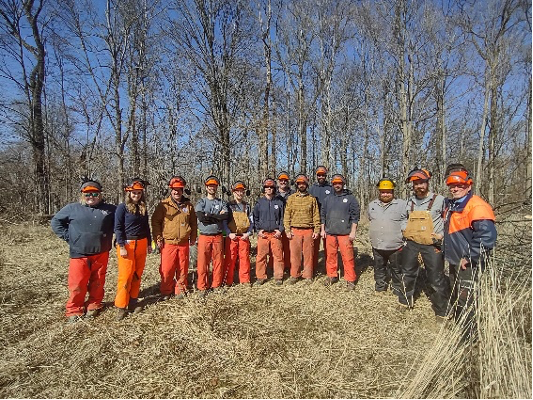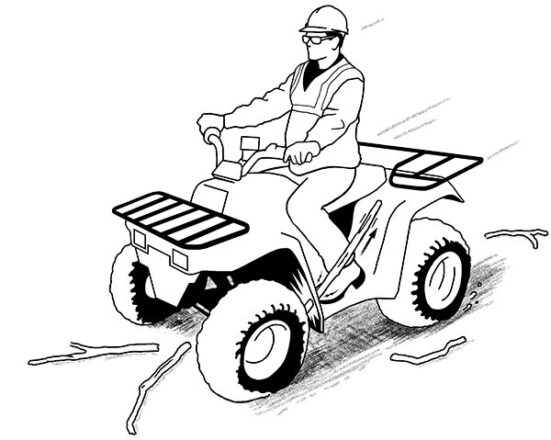Logger Training and Education Doesn’t Stop at the State Line

Right now, your FRA team is working on getting together the state “Logger Training and Education” (LT&E) summaries for 2022. They will then be summarized for the Sustainable Forestry Initiative program and published in a report. That report gives us the status of LTE in 32 forested U.S. states and 4 Canadian provinces for 2022. It will summarize the type of training completed and how many loggers or employees are participating.
In 2021, 1,954 logging contractors, 1,475 logging company employees, and 266 non-loggers completed their LT&E program requirements. Others participating in LT&E programs include foresters, landowners, consultants, students, government officials, and natural resource managers. That’s a lot of training in many different places!

Every state has basic requirements that loggers must complete. A few of those courses are Best Management Practices (BMPs), Chainsaw Safety (chainsaw or mechanized felling), and CPR & First Aid. Additional Continuing Education training is available for loggers and others. Some of these courses are unique and specifically developed for the regions where loggers work. For example, Kentucky provides a White Oak Production and Harvesting Continuing Education course. White Oak is on the decline in the Appalachians, and a lot of attention is focused on that tree species at the moment. Not only is White Oak an excellent wildlife tree because of the mast (acorn) production, but it’s the only species used for barrel staves. White Oak barrels are used to age and color whiskey for a growing bourbon industry! If you don’t use White Oak, you have porous barrels, which, in turn, leak! Appalachian loggers are on the front lines of this issue! Learn more about White Oak here: www.whiteoakinitiative.org.
Another example of Continuing Education training that’s unique is found in Louisiana. They offer a training module webinar educating attendees about the ‘Invasive Feral Hogs.’ I live in Ohio, and we don’t have a big problem with feral hogs, but after visiting Georgia earlier this spring, I know they do! I saw firsthand what hogs can do to the environment, the forest, and local wildlife. They are destructive and prolific! In my opinion, you can’t start early enough when it comes to controlling an already’ out of control’ hog population.
Before I wrap this up, I want to share a visit I had last week with a timber cutter that I know. His name is Dallas, and I’ve known him for 30+ years. We aren’t close friends, but we know each other because he’s worked for many loggers who I’ve worked with. We have a history with each other and more respect for one another than anything. He’s a smart and experienced guy who underwent chainsaw training in the early 1990s. The training was the “Game of Logging.” As we discussed everything, he commented that his original opinion was that the cutting technique was too slow to be practiced in real-life logging and would only cause a loss in production. He only went to the training because I bugged him about it, but in hindsight, he said he was wrong. The training was very beneficial, and he thanked me for nagging him. He said it probably saved his life and knew that the training had saved many cutters over the years.
It was encouraging to hear something we did ‘way back when’ made a difference to one guy and that he appreciated it. The saddest part of this story is that Dallas is now restricted to a wheelchair. I stopped by because I’d heard that he’d been badly injured a few years earlier while felling a tree. That tree had hit another tree while it was falling and caused the second tree to come back toward him. He didn’t see it in time to get away. The tree crushed the left side of his body and nearly took his life. We sat there on his porch reminiscing about the good times, and while we were talking, three log trucks passed by in that short amount of time. Each driver honked a hardy “hi there,” letting him know he was on their mind! I want to say that training will always prevent accidents or fatalities, but we all know that’s not the world we live in.
Logger training doesn’t exist just to satisfy a state law or to put a check in the box. It makes all of us better at what we do. It’s helping to save lives, providing new techniques to keep us safer and more efficient, and giving us the knowledge that we need to fight a threat to the forest or our industry. A lot of time, money, and attention has been spent on LT&E, and the SFI Report provides names of courses and contact information for the state training organizations to anyone interested. If you want to see what’s going on in your state, or surrounding states, look through the most recent LT&E report and get some of the answers you’ve been looking for! https://www.sfiofpa.org/_download_link.php?did=32
**The 2023 SFI Logger Training and Education report will be available later this year. Some of the changes in the 2023 report are the loggers trained in 2022, updated contact information, and the additional Continuing Education courses being offered.



